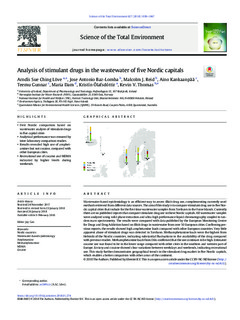| dc.contributor.author | Löve, Arndis Sue Ching | |
| dc.contributor.author | Baz-Lomba, Jose Antonio | |
| dc.contributor.author | Reid, Malcolm J | |
| dc.contributor.author | Kankaanpää, Aino | |
| dc.contributor.author | Gunnar, Teemu | |
| dc.contributor.author | Dam, Maria | |
| dc.contributor.author | Ólafsdóttir, Kristín | |
| dc.contributor.author | Thomas, Kevin V | |
| dc.date.accessioned | 2019-05-10T09:27:40Z | |
| dc.date.available | 2019-05-10T09:27:40Z | |
| dc.date.created | 2019-01-25T15:15:40Z | |
| dc.date.issued | 2018 | |
| dc.identifier.citation | Science of the Total Environment. 2018, 627, 1039-1047. | nb_NO |
| dc.identifier.issn | 0048-9697 | |
| dc.identifier.uri | http://hdl.handle.net/11250/2597211 | |
| dc.description.abstract | Wastewater-based epidemiology is an efficient way to assess illicit drug use, complementing currently used methods retrieved from different data sources. The aim of this study is to compare stimulant drug use in five Nordic capital cities that include for the first time wastewater samples from Torshavn in the Faroe Islands. Currently there are no published reports that compare stimulant drug use in these Nordic capitals. All wastewater samples were analyzed using solid phase extraction and ultra-high performance liquid chromatography coupled to tandem mass spectrometry. The results were compared with data published by the European Monitoring Centre for Drugs and Drug Addiction based on illicit drugs in wastewater from over 50 European cities. Confirming previous reports, the results showed high amphetamine loads compared with other European countries. Very little apparent abuse of stimulant drugs was detected in Torshavn. Methamphetamine loads were the highest from Helsinki of the Nordic countries, indicating substantial fluctuations in the availability of the drug compared with previous studies. Methamphetamine loads from Oslo confirmed that the use continues to be high. Estimated cocaine use was found to be in the lower range compared with other cities in the southern and western part of Europe. Ecstasy and cocaine showed clear variations between weekdays and weekends, indicating recreational use. This study further demonstrates geographical trends in the stimulant drug market in five Nordic capitals, which enables a better comparison with other areas of the continent. | nb_NO |
| dc.language.iso | eng | nb_NO |
| dc.publisher | Elsevier | nb_NO |
| dc.rights | Attribution-NonCommercial-NoDerivatives 4.0 Internasjonal | * |
| dc.rights.uri | http://creativecommons.org/licenses/by-nc-nd/4.0/deed.no | * |
| dc.title | Analysis of stimulant drugs in the wastewater of five Nordic capitals | nb_NO |
| dc.type | Journal article | nb_NO |
| dc.type | Peer reviewed | nb_NO |
| dc.description.version | publishedVersion | nb_NO |
| dc.rights.holder | © 2018 The Authors | nb_NO |
| dc.source.pagenumber | 1039-1047 | nb_NO |
| dc.source.volume | 627 | nb_NO |
| dc.source.journal | Science of the Total Environment | nb_NO |
| dc.identifier.doi | 10.1016/j.scitotenv.2018.01.274 | |
| dc.identifier.cristin | 1665271 | |
| cristin.unitcode | 7464,30,21,0 | |
| cristin.unitname | Miljøkjemi | |
| cristin.ispublished | true | |
| cristin.fulltext | original | |
| cristin.qualitycode | 2 | |

